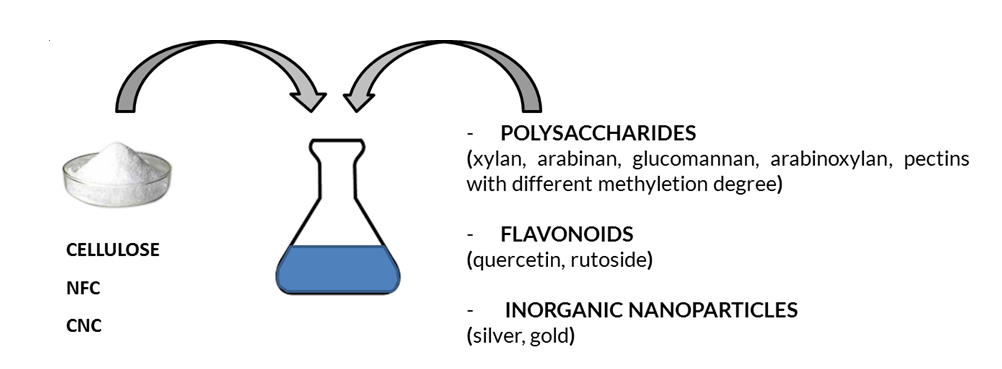Cellulose is the most widespread, naturally occurring polymer on Earth. It is the main building component of plant cell walls. Each cellulose molecule is a linear polymer consisting of one thousand to one million sugar units of D-glucose, connected to one another by a β-1,4-glycosidic link. From the point of view of chemical composition, cellulose originating from various sources consists of the same elements, however, taking into account its structure on a micro scale, it may display a different crystal structure. In recent years, the trend is to modify the surface of cellulose in order to obtain a material with new properties and applications. Therefore, it is proposed to use cellulose as an adsorbent, while as adsorbents:
- cell wall polysaccharides (model studies simulating interactions occurring in the plant cell wall);
- flavonoids and other bioactive substances (cellulose as a carrier of active substances);
- inorganic nanoparticles (cellulose as part of biosensors).
Plant polysaccharides perform many biological functions, they can also be used as functional materials in food engineering, pharmacy, medicine, as components of packaging and construction materials. In order to understand the real influence of pectin and hemicellulose on the structure of cellulose microfibrils, or to determine the interactions between individual substrates forming the cell wall, in vitro studies are necessary, i.e. physicochemical studies of cellulose, as an adsorbent and pectins and hemicelluloses as adsorbates. So far, adsorption studies have been carried out using commercially available pectins and xyloglucan [4]. Next, it is planned to extend the research to other types of hemicelluloses (xylan, arabinan, glucomannan, arabinoxylan) and pectins (with various degrees of esterification). However, further plans include also the use of polysaccharides isolated from plants, and then their characterization and use for adsorption studies in cellulose-pectin or cellulose-hemicellulose systems.
In contrast, flavonoids are substances of plant origin that act as dyes, antioxidants, or natural fungicides and insecticides. Their antioxidant activity, conditioned by the ability to inhibit the activity of lipoxygenases and cyclo-oxygenases and the ability to chelate transition metal ions (eg iron), which participate in the reactions leading to the production of reactive oxygen.
On the other hand, cellulose functionalized with inorganic nanoparticles is used as an element of biosensors, materials used in catalysis, conductive materials and in the paper industry, as well as fabrics with antibacterial properties or in active and intelligent food packaging. Therefore, the aim is to study the nature of interactions between cellulose (microfibrillary, nanofibrillary or in the form of nanocrystals) and metallic nanoparticles, as well as investigating the properties of newly obtained structures. One of the methods of biofunctionalisation of cellulose nanostructures is the introduction of metal nanoparticles (Ag, Au, Pt, Cu, Pd, Co) or metal oxides (ZnO, CuO) and carbon nanostructures (carbon nanotubes, graphene) onto their surface. Colloidal metal nanoparticles are interesting because of their unique optical, electronic, magnetic and antibacterial properties. Due to their small size, large specific surface area and tunable physicochemical properties, which differ significantly from their counterparts in macroscopic form, they find application in nanocomposite materials.
The obtained adsorption systems will be tested for their physico-chemical properties by the following methods:
- atomic force microscope (AFM) – surface imaging and mechanical properties at the nano scale
- FT IR and FT Raman spectroscopy, Raman microspectroscopy – structure and interaction between components
- thermal analysis (DSC)
- chemical analysis
- Zeta potential research, particle size.
For more information please see:
- C. Zhu, I. Dobryden, J. Rydén, S. Öberg, A. Holmgren, A. P. Mathew, Adsorption Behavior of Cellulose and Its Derivatives toward Ag(I) in Aqueous Medium: An AFM, Spectroscopic, and DFT Study. Langmuir, 2015, 31 (45), pp 12390–12400
- H. Tian, J. He Cellulose as a Scaffold for Self-Assembly: From Basic Research to Real Applications. Langmuir, 2016, 32 (47), pp 12269–12282
- J. Cybulska, A. Brzyska, A. Zdunek, K. Woliński, AFM study on pectin structure form carrot and simulation of force spectroscopy of galacturonic acid molecules. PLOS One, 2014, 9(9):e107896.
- D. Myśliwiec, M. Chylińska, M. Szymańska-Chargot, S. Chibowski, A. Zdunek, Revision of adsorption models of xyloglucan on microcrystalline cellulose. Cellulose, 2016, 23 (5), pp. 2819-2829













